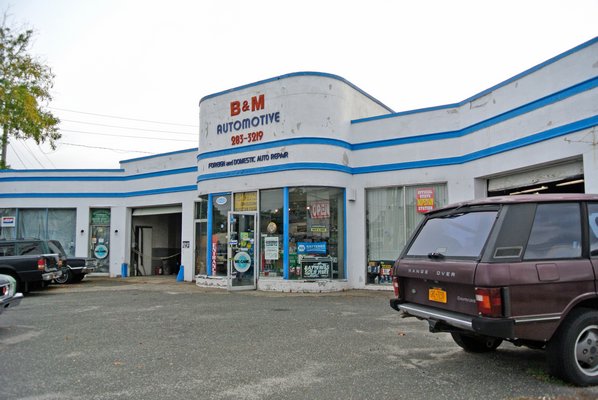
The owners of an Art Deco-style automotive shop and former car dealership in the heart of Southampton Village—where Windmill, Jobs and Pond lanes, and Hill Street, all come together—are one step closer to getting approval to demolish the building, although the building’s owners say they have no current plans to do so.
Members of the Southampton Village Board of Architectural Review and Historic Preservation on Monday closed the public hearing for an application submitted by the Hauquitz family, who own the 5,600-square-foot building that houses B & M Automotive at 1 Pond Lane, seeking a certificate of appropriateness that ultimately could lead to the demolition.
Representatives for the family have said that they only want the permit to make it clear to potential buyers of the property, which is on the market for just under $4.2 million, that it could be demolished if the buyer chooses.
ARB Chairman Curtis Highsmith and board members Christina Redding and Susan Stevenson all voted to render a written decision to approve the certificate of appropriateness. That written decision then would come back before the board for final action, most likely at the board’s next meeting on February 26.
ARB member Jeff Brodlieb voted against the measure, saying he didn’t see it as the board’s role to help facilitate the sale of the property—and he wondered aloud if a buyer might come forward who would preserve the site.
The building “could be re-purposed,” Mr. Brodlieb said. “Perhaps there is a buyer out there who would re-purpose it.”
The property is located in the village’s historic district, but it does not appear on any formal list of historic buildings. Still, the location in the historic district requires that any proposed demolition or alteration must be approved by the ARB.
The list that designates whether a building contributes to the historic district was created in 1979. According to Zachary Studenroth, the board’s architectural consultant, the former auto dealership, which was built in 1951, was only 27 years old at the time and didn’t qualify—and the list has never been updated.
In January, Mr. Studenroth presented board members with images of other Art Deco buildings that were curved in shape, made of stucco and sheet metal, and had large plate glass windows. He told the board that the designs were employed during the postwar era for the sale of modern products like automobiles.
Mr. Studenroth’s point was to try to convince the board that the building could possibly be designated as a historical structure.
“I would suggest, we are all growing older,” Mr. Studenroth told board members. “The buildings we are living with … are also growing older.”
On Monday, Mr. Highsmith told Mr. Studenroth and the other board members that he did not think the building “rose to the level of [historical] designation.”
“It’s not currently a contributing structure within the historic district,” Mr. Highsmith said. “For me, it would take a lot more for it to rise to that occasion.”
Mr. Highsmith added that he rarely goes against Mr. Studenroth’s recommendation, but this time he could not see himself agreeing that the building should be preserved.
In September, Linda Kabot, a real estate agent and former Southampton Town supervisor who was representing the Hauquitz family, said that potential buyers wanted to know what they could do with the property. In particular, she said, potential buyers had asked whether they could expand—or even demolish—the building.
Mr. Brodlieb said if the application were put to a vote, he would abstain or vote not to demolish the building. His reasoning for abstaining was that he did not think it was the board’s responsibility to help facilitate a sale.
“The original representative made that a point of the application,” Mr. Brodlieb said of Ms. Kabot. “I don’t think we should be put in that position.”
Mr. Highsmith said the only time the board looks at financial gain or loss is when an application of hardship is before them. At all other times, he said, the board must look at applications individually and independent of the applicant’s intent to sell the property.
On Tuesday, Southampton Village-based attorney John Bennett—who began representing the Hauquitz family in December—said Mr. Brodlieb was correct in saying that the board should not be put in a position to facilitate a sale. But he added that the issue was irrelevant, unless the building is a contributing structure, which in this case it is not.
While the building dates back to 1951, the property has a richer history. Merritt and Caroline Marshall Culver owned a farm on the corner of Pond Lane and Culver Hill, and a house sat on the property, which is now 1 Pond Lane, until the early 1900s, according to documents kept by the Southampton Historical Museum.
Maps created in 1927 and updated in 1932 show that an automotive sales shop and gas station had been built on the property in place of the home.
The same maps depict a Hill Street lined with car dealerships and automotive repair shops, along with a machine shop. That had been the nature of Hill Street since the late 1800s, when the Culvers’s son, George, opened up a carriage shop at 16 Hill Street, where he repaired, painted and built carriages. That business was handed down to his son, Arthur Culver, in 1913, documents show.